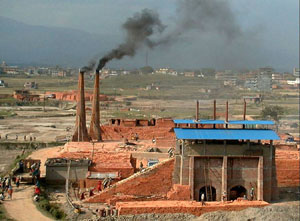M.C. Mehta v. Union of India and Ors.
Bench: B.N. Kirpal, Mrs. Ruma Pal
Citation: Writ Petition (Civil) 4677 of 1985
Contemporary Relevance of the case
Brick kiln industries have been a major source of air pollution in Delhi-NCR and other States. That is one of the reasons that the industries are located at the border of Delhi so that they fallout of the NCR region and the fact being that this doesn’t create any remark in the reduction of air pollution as these industries need to realise that the amount of pollution they make is huge and they must shift to a cleaner technology.
Currently, we still have 2080 brick kiln industries operating in the districts of Ghaziabad, Gautam Budh Nagar and Hapur. The Supreme Court has mandated the ENVIRONMENT POLLUTION (PREVENTION AND CONTROL) AUTHORITY to give one last window to them. They were supposed to operate till June 2018. An opportunity in the form of Zigzag system has been given to them and if they install that they can continue their operation. The advantages attached to this system are of utmost importance as it forces the air to spend more time inside of the kiln which generates good transfer of heat. The emissions out of it remain at a lower tendency and the quality of the brick that comes out is much better.
The brick kiln industries have been observed to be one of the five largest industries of the consumer user of coal and there are severe concerns of environment associated with it.
Facts of the case
An order in relation to close down of the brick kiln industries was issued on 10th May 1996 in which the industrial owners were suppose to surrender their land without being paid any compensation in relation to their sacrifice. However, another order dated 26th January 1996 was made in which whether the brick kiln industries were falling in category “H” or not. By this order, they did fall in the above mentioned category. The conclusion drawn by this order was made on the basis of a report that was furnished by DELHI POLLUTION CONTROL BOARD. The various objections were filed by the brick kiln owners numbering to 246 and then this repost was made.
No notice was issued to these brick kiln owners and thereby, their own rights were severely affected. A writ petition was therefore filed for the modification to take place in such orders. The Master Plan of 1990 said for the relocation and shifting of these industries within a time span of three years. These industries were to be stuck out of the Delhi region. The brick kiln industries were included in this as they did not fall in the category “H”. It was after the report was made by DELHI POLLUTION CONTROL BOARD. The industries that failed to move out lead to the order dated 10th May 1996.
Realisations for the situation that the brick kiln industries were not in the same position as that of the other industries. These industries were located on the agricultural land and therefore for the construction to take place, the procedure was not the same. The Floor Area Ratio In the order dated 10th May was offered by the way of compensation but this could not take place as agricultural land has been used for bricks.
An affidavit was file on 6th September 1996 by D.S. Negi Secretary of Environment cum Chairman, DELHI POLLUTION CONTROL BOARD which stated that the brick kiln industries do fall in the category “H”. The employees affected by such closures or relocation and shifting of the brick kiln industries were authorised to have their employments in the shifted location on the basis of the terms of the contract. They were entitled to their full time wages. The time duration between the processes involved they were paid in full. They also got a shifting bonus. The rules that were applicable to Section 25-B of the Industrial Dispute Act 1948 were made applicable to them too. The provisions for retrenchment were also made applicable to them. The gratuity calculated was also made available to the employees.
The technology of fly-ash sand lime mixture has gained importance in recent times. Although the technology involves a huge cost investment and inadequacy of time but we can also see that the technology has been well settled for example, in West Bengal and it has proved to be very effective. The above mentioned technology will reduce the amount of pollution by seventy-eighty times. The technology needs to be made more familiar in the current era. People need to be made aware about it. And this can achieve by conducting workshops and the training programs.
A last window has been given to the four states to make a conversion for their current use of technology or to close down their operating industries. A very important point in this regard becomes the quality of conversion. To state of the situations here, one, Raj Kumar Yadav in the Jhajjar district of Haryana just by changing the shape of the wall tried to reduce the amount of pollution. He was not successful though but tried to mock the technology or in the other words he tried to befool the entire process.
Seventy-four % of the kiln owners couldn’t make this shift. The problem faced by these owners was majorly related to labour.
Environment Pollution (Prevention and Control) Authority ordered that the shift to zigzag technology is necessary. There were surveys that were published by Delhi-based non-profit centre for Science and Technology (CSE). It also says for the compliance of such records and surveys.
There are certain disadvantages to the current use of technology which includes the Mayan’s improper design and dimensions which lead to hindrance in the movement of air and reduced efficiency. There is a stack/emission monitoring facility which was found to be missing in 88% of the kiln industries that was surveyed. A lot of crack and leaks were also found. There was no facility for the storage of fuel.
Vijay Goel, the President of All India Brick and Tile Manufacturing Federation said that the conversion is unlikely. There are still number of illegal operations that are being in operation.
One Sailesh Singh has filed a petition in the same regard for the operation of numerous brick kiln industries being still operated in many areas. He says that Uttar Pradesh, Haryana, Rajasthan and Delhi have been in non-compliance of the pollution norms relation to air and water pollution. They have not obtained the necessary permissions for the same. Also there was one Joy deep Mukherjee who was concerned with illegal operations of brick kiln owners in the State of Jharkhand without the consent the State.
CONCLUSION
Order of compensation was passed in this relevant case. To conclude, reduction of air pollution is a goal far yet to be achieved. By the relocation and shifting to a cleaner technology as suggested, these industries can run more efficiently and effectively.
By-
Vanshika Garg (Amity Law School, Noida)
Ragini Sharma (Amity Law School, Noida)
Previous post: https://desikanoon.in/ms-shriya-maini-on-qualifying-the-advocate-on-record-examination-2019-in-the-first-attempt/



